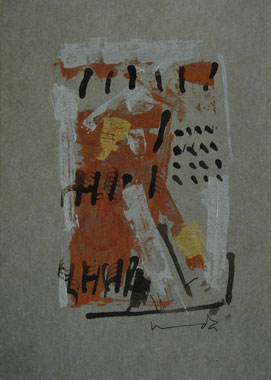The poet in Nitin takes pen to paper. The painter in him takes ink to paper. Just as the words tumble down to weave a lyrical pattern of poetry on paper so does the ink from his brush glides on the paper / canvas spontaneously and sensually. Monochromatic painting is a meditative art. The exploration of one single colour predominantly Black in his work, the examination of values changing across a surface, the expressivity of texture and nuance all express a wide variety of emotions, intentions and meanings. Monochromatic chantical voices expressing the records from ages beyond.
These spontaneous abstractions use only black ink or shades of black. Ink is a complex medium, the oldest traditional material. The components of ink serve many purposes – the ink’s vehicle and colourants are used to control flow, thickness and appearance of the ink when dry. This way he suggests purity and spirituality mysticism and death.
In these works ink is often used and removed with water or tea stain thus establishing relationship between the unknown forms and lives. Tones of Sepia (tea stain), grey and black of ink give a fertile ground to establish these unknown forms. The meaning of these unknown forms seems to be revealed by the glow of an inner light coming from the fusion of ink with water. It looks almost like a manuscript page of a forgotten language.
Nitin has used ink in a non-representational way yet these lines look like calligraphic signs and they sometimes even take an appearance of a fading graffiti. Sometimes it keeps only an allusion of the original alphabet likes ‘K’ or ‘keÀ ’. His brushstrokes catch a sense of movement. All this is achieved by intuitive and loose ink handling, spontaneous expression and illusionist use of space.
Most of his creations are a result of a direct drawing, calligraphic use of line, the effects of brushed, splattered, stained and splashed ink that work in tandem to create the lyrical effect. The repetition of some lines and form are like the refrain of a favourite song that gives the effect of a skillfully knitted and woven fabric. Departing from representational accuracy, forms are either simplified or exaggerated.
Nitin has played with black and white. The brushstrokes display a strong control of large areas, giving expression to his emotion and focus on the inner energy, contemplation, creating expressive, lyrical and thoughtful facets to the paintings. Sometimes the application of brushstrokes is contemplative, slow and purposeful using the passage of time as an asset. Sometimes the strokes are intuitive, energetic, fast and random. The final outcome is lyrical, echoing the forgotten scripts or the musical notations – a flow and rhythm of calligraphic form, lines and shapes.
Nitin Dadrawala’s “Ink on Paper” reveals the unknown, the unknown depths of psyche, or of something greater than the psyche. Here in begins his lyrical voyage.
By: Suvrata Samant

